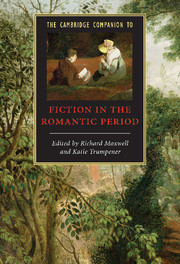Book contents
- Frontmatter
- Introduction
- 1 The historiography of fiction in the Romantic period
- 2 Publishing, authorship, and reading
- 3 Gothic fiction
- 4 The historical novel
- 5 Thinking locally: novelistic worlds in provincial fiction
- 6 Poetry and the novel
- 7 Orientalism and empire
- 8 Intellectual history and political theory
- 9 Women writers and the woman’s novel: the trope of maternal transmission
- 10 Tales for child readers
- 11 Sentimental fiction
- 12 Fiction and the working classes
- 13 The Irish novel 1800-1829
- 14 Scotland and the novel
- Further reading
- Index
- Series List
6 - Poetry and the novel
Published online by Cambridge University Press: 28 January 2009
- Frontmatter
- Introduction
- 1 The historiography of fiction in the Romantic period
- 2 Publishing, authorship, and reading
- 3 Gothic fiction
- 4 The historical novel
- 5 Thinking locally: novelistic worlds in provincial fiction
- 6 Poetry and the novel
- 7 Orientalism and empire
- 8 Intellectual history and political theory
- 9 Women writers and the woman’s novel: the trope of maternal transmission
- 10 Tales for child readers
- 11 Sentimental fiction
- 12 Fiction and the working classes
- 13 The Irish novel 1800-1829
- 14 Scotland and the novel
- Further reading
- Index
- Series List
Summary
Rhymesters fail when they try to write prose. In prose there are no empty syllables to fill up; something absolutely has to be said. - But, Monsieur, Walter Scott also wrote poems . . .
(Balzac, Illusions perdues)Tell me but this - is there poetry in it?
(Scott, The Pirate)The oil of poetry and the water of prose do not mix easily. There have indeed been exceptions: the carnivalesque mode of Menippean satire; the self-designated (and isolated) medieval “chantefable” (tale with inserted poems) Aucassin et Nicolette; the Renaissance pastoral romance and its parody in Don Quixote. And then there is the genre at the center of this chapter, which I shall designate the “Romantic novel.” Adapted from German, this term will include not just novels with poems in them, but also short prose narratives (stories and novellas) that include poems as well as verse narratives with incorporated lyrics. The first “Romantic novel” in this sense is perhaps Oliver Goldsmith's Vicar of Wakefield (1766), with its famous ballad “Edwin and Angelina,” its “Ode on the Death of a Mad Dog,” and its sentimental lyric “When lovely woman stoops to folly”; in English the last major examples are some tales of Edgar Allan Poe and the familiar twin peaks are Ann Radcliffe and Walter Scott (though instead of Radcliffe I shall discuss the slightly earlier instance of Charlotte Smith, a more productive author and a better poet).
- Type
- Chapter
- Information
- The Cambridge Companion to Fiction in the Romantic Period , pp. 107 - 128Publisher: Cambridge University PressPrint publication year: 2008



